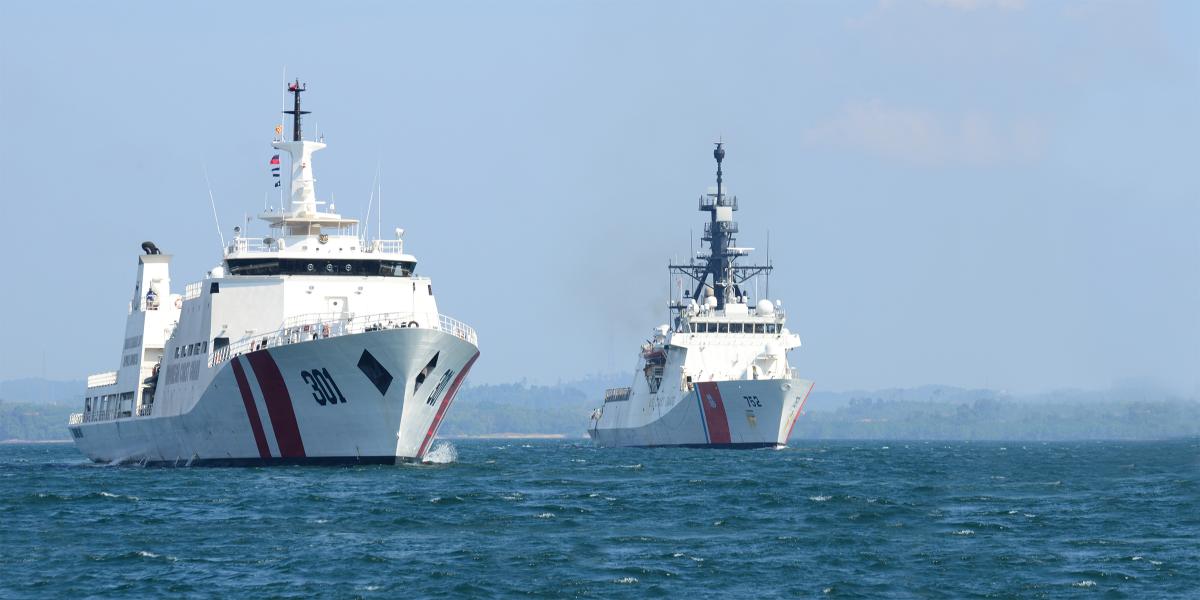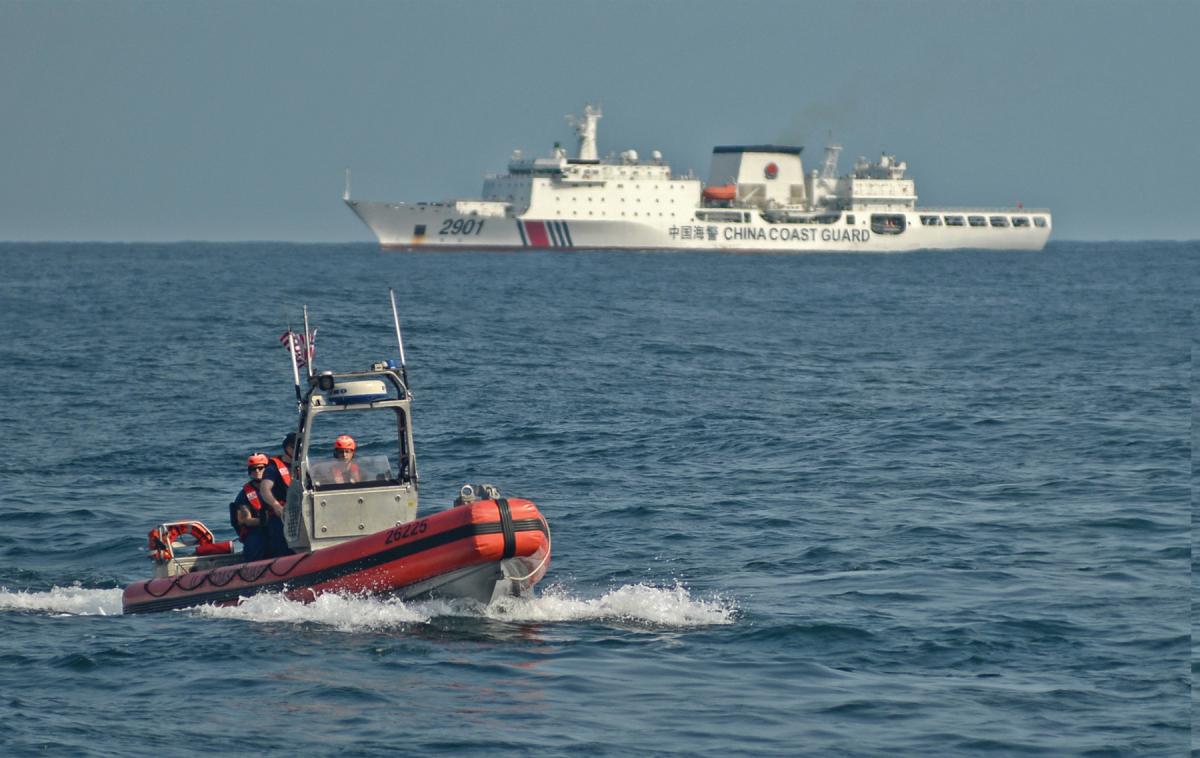Some say this is “The Era of the Coast Guards” for Asian nations.1 Amid conversations about the return to great power competition, gray zone aggression, and fait accompli actions, however, the U.S. Coast Guard has been left out. As part of the Department of Homeland Security, its statutory missions include law enforcement and facilitating maritime traffic, but it also is prepared to assist in the national defense should it be called back to the Department of Defense. This dual-hat nature makes the Coast Guard a valuable force in competition below the threshold of armed conflict. It needs to be closer to the center of U.S. strategy in the Indo-Pacific region to allow the United States to compete with China symmetrically and to complement existing Navy and Marine Corps strategies.2
China’s Maritime Forces
Andrew S. Erickson, a scholar at the Naval War College, argues that “China has three navies: the regular navy, the police navy, and the sneaky navy.”3 Aside from the People’s Liberation Army Navy, there is the People’s Maritime Law Enforcement, which includes China’s coast guard, and a People’s Armed Forces Maritime Militia. Each has more ships than any other maritime service globally. In just the past few years, China has, according to Erickson, increasingly consolidated and streamlined the command structure for these services—akin to aligning them all under the combatant commander and aggressively employing them in support of national strategic objectives.
In 2012, Chinese maritime militia and coast guard ships faced off against the Philippine Coast Guard near Scarborough Shoal, a group of disputed low-lying islands the Permanent Court of Arbitration has declared sovereign to the Philippines. Despite the outcry from the international community, many paramilitary Chinese ships are still there. In 2013, Chinese paramilitary ships dramatically increased their violations of Japanese waters around the Senkaku Islands—from almost none to two dozen. Since then, the trespassing has increased in frequency to an almost permanent presence.4
In 2018, China “swarmed” more than 275 mixed-purpose vessels near Thitu, a Philippine-controlled island in the Spratly Islands.5 In 2019, vessels from the People’s Armed Forces Maritime Militia were accused of using lasers to harass and interfere with Royal Australian Navy helicopters.6 But these incidents are only the few that have made the news. Chinese maritime paramilitary forces have made harassment, interdiction, and interference with foreign civilian, law enforcement, and military vessels a daily occurrence with aggressive maneuvering, ramming, and water cannons designed to damage sensitive equipment and flood generators.7
The U.S. Coast Guard is Capable
Enter the U.S. Coast Guard. In its most recent strategic guidance, the Coast Guard notes the “return to great-power competition,” “maritime hybrid warfare,” and “gray zone activities” as threats facing the United States and its allies—and the service’s ability to counter such threats.8 The unique capability of the Coast Guard is not lost on the Department of Defense; in the 2018 National Defense Strategy, former Secretary of Defense James Mattis called for “the seamless integration of multiple elements of national power” including “law enforcement” to generate advantage and expand the competitive space.9 Further underscoring the potential is a recent joint transit of the Taiwan Strait by the USS Curtis Wilbur (DDG-54) and USCGC Bertholf (WMSL-750).10
The U.S. Coast Guard’s law enforcement capabilities are essential in the Indo-Pacific region. As China expands the reach and scale of its paramilitary and maritime law enforcement organizations, other Pacific nations are trying to keep up. This competition provides opportunities for the Coast Guard to train and partner with other Pacific nations to improve their capabilities and strengthen ties. They can teach and develop law enforcement skills while the Navy focuses on higher end missions.
Fishery and maritime rights enforcement near disputed islands? Check. Harbor security and sanctions regimes? Check. High-value escort? Check. Maritime search and rescue? Check. In the far northern Pacific and Arctic, the Coast Guard also has key capabilities for U.S. strategy. It sails the only U.S. icebreakers and operates key bases in Alaska, where it has maintained a constant presence.
Pacific nations, particularly in the South Pacific, are crying out for more engagement with the United States, especially for help with maritime law enforcement issues such as “illegal fishing, human- and narco-trafficking, unlicensed mineral exploitation, and pollution.”11 But these nations have said if they cannot get what they want from the United States they will have no choice but to entertain Chinese entreaties. The U.S. Coast Guard can engage with these nations and compete with China and its large infrastructure projects in the region.
A permanent Coast Guard presence in the Indo-Pacific would not be the service’s first permanent overseas deployment—the service has been deployed in the Persian Gulf since 2003—and such a presence in the Indo-Pacific reportedly was discussed by the prior Commandant.12 International security and law enforcement cooperation by the Coast Guard can demonstrate U.S. commitment to the rules-based international order.
The Coast Guard Package
Almost as important as the capability it provides is the package. Coast Guard ships and their distinct white paint scheme represent maritime rule of law. They are inherently nonthreatening except to poachers in protected waters. There is a long history of U.S. warships enforcing dominion over Pacific lands, but Coast Guard ships send a different and important message. They are more difficult to construe as tools of empire and far less imposing than aircraft carriers and cruisers.
But the white Coast Guard vessels are not undefended. The ships are armed, have a combatant history, and have even in some instances been armed with antiship missiles.13 This is especially important, as the China Coast Guard has been commissioning larger and larger ships—the largest law enforcement vessels in the world.14 U.S. Coast Guard ships can play a key role in emerging concepts, such as distributed maritime operations, and expand U.S. presence in a nonthreatening way.
The Underfunded Service
Despite its promise, the Coast Guard still is significantly underfunded and underresourced; arguments against leveraging the Coast Guard as a tool for great power competition in the Pacific region have hinged on this fact.15 The Department of Defense increasingly has been leaning on the Coast Guard to supplement the Navy, and the Navy “can’t foot the growing bill.”16 The 2020 Coast Guard budget reflects an almost 10 percent reduction from 2019, despite the service’s inability to replace its ships at a sustainable rate or acquire new icebreakers.17
The Coast Guard also has indicated it believes its current program of record for cutter procurement across all classes will only meet 61 percent of what is “needed to fully perform the service’s statutory missions in coming years.”18 This gap is highlighted against the backdrop of record defense spending on the other services and the stated goal of the Navy to increase its fleet. Until it is properly funded, the service will continue to be underused in the Indo-Pacific region.
As the joint force continues to reorient on great power competition, and China and Russia specifically, the U.S. Coast Guard must become a primary tool integrated into the “Navy–Marine–Corps–Coast Guard Team.”19 The United States cannot expect to deter gray zone actions solely with its gray-hulled military fleet. But the recent Department of Defense Indo-Pacific Strategy Report casts doubt on an expanded role for the Coast Guard. It is discussed only twice in 64 pages—once in reference to the transfer of a security cutter to Vietnam and once in a blurb about South Pacific engagement—despite emphasis throughout the document on law enforcement activities and expanding partnerships.20 The Coast Guard offers unique opportunities for both and capabilities that do not exist in the Navy. But, to realize its potential, Coast Guard funding must be prioritized to be on par with the other armed services. The white ships of the U.S. Coast Guard can play a role in the Indo-Pacific, but their value can only be realized if the service is given the funding and the opportunity to operate in the region.
4. James E. Fanell and Kerry K. Gershaneck, “White Warships and Little Blue Men: The Looming ‘Short, Sharp War’ in the East China Sea over the Senkakus,” Marine Corps University Journal 8, no. 2 (Fall 2017): 70–76. “Military and Security Developments Involving the People’s Republic of China 2019,” report to Congress, Office of the Secretary of Defense (2019), 71.
5. Jim Gomez, “Manila Protests ‘Swarming’ Chinese Boats Near Island,” Navy Times, 1 April 2018.
8. ADM Karl L. Schultz, USCG, Coast Guard Strategic Plan 2018–2022, U.S. Coast Guard (November 2018), 4.
9. GEN James Mattis, USMC (Ret.), National Defense Strategy, Department of Defense (2018), 4.
11. John Grady, “Pacific Island Nations Want More U.S. Engagement,” USNI News, 15 May 2019.
14. Fanell and Gershaneck, “White Warships and Little Blue Men.”
17. Ben Werner, “New Budget Forces Tough Funding Choices for Coast Guard,” USNI News, 27 March 2019.
18. “Coast Guard Cutter Procurement: Background and Issues for Congress,” Congressional Research Service, 22 May 2019, 16.




